MARIANI’S
June 15, 2008
NEWSLETTER
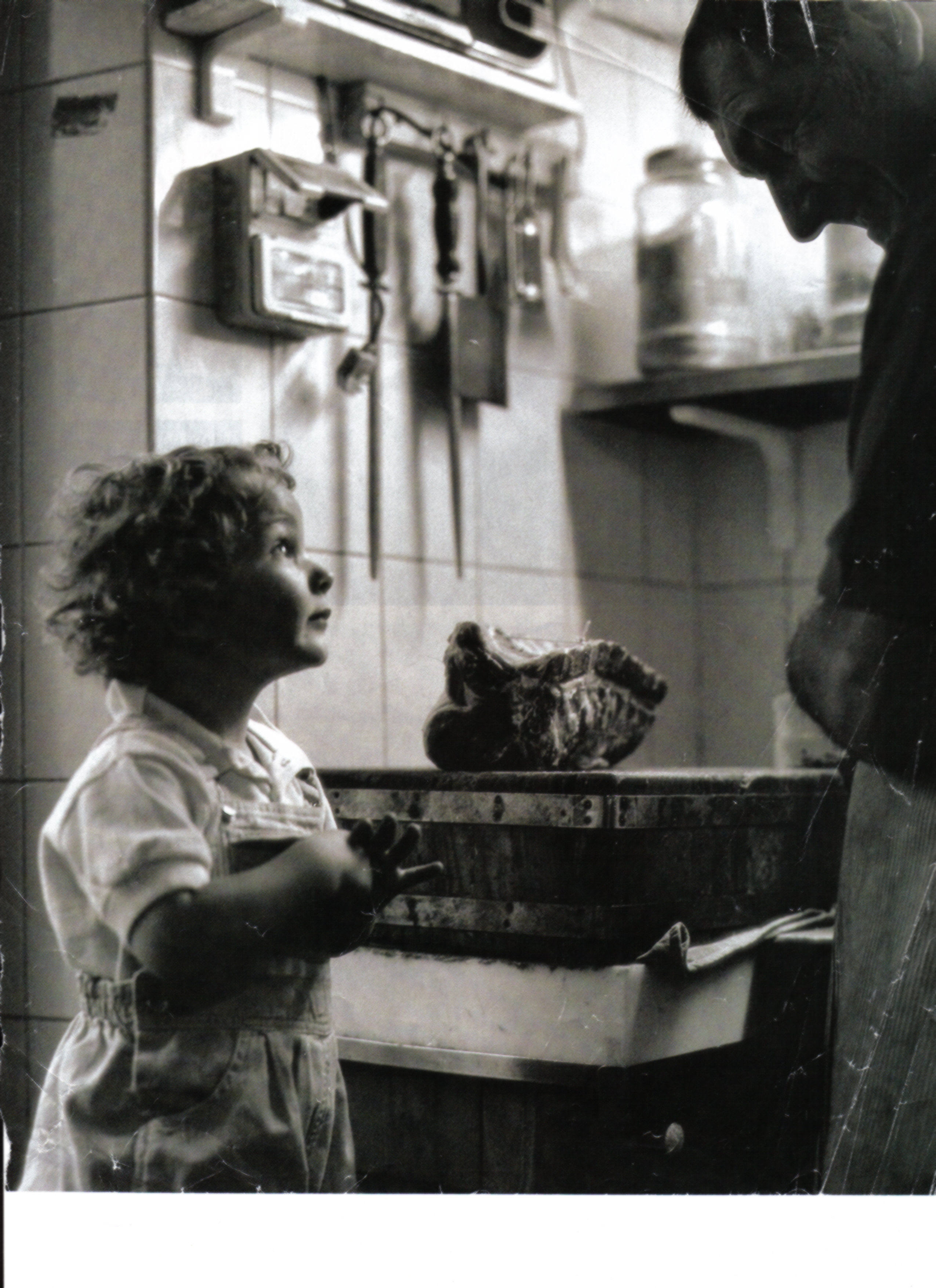
HAPPY FATHER'S DAY!
NEW! Click esquire.com
to go to my new column at Esquire Magazine.
ARCHIVE: Readers may now access
an
Archive of all past newsletters--each annotated--dating back to July,
2003, by simply clicking on www.johnmariani.com/archive
SUBSCRIBE AND
UN-SUBSCRIBE: You may subscribe anyone you wish
to this newsletter--free of charge--by
clicking here.
In
This Issue
NEW YORK CORNER: PadreFiglio by John Mariani
THE JAMES BEARD AWARDS 2008 by John Mariani
NOTES FROM THE WINE CELLAR: Now They All Copy Clos du Val by John Mariani
QUICK BYTES
~~~~~~~~~~~~~~~~~~~~~~~~~~~~~~~
STAYING IN AND DINING OUT IN ROME, Part One
by Edward R. Brivio
Photos by Robert Pirillo
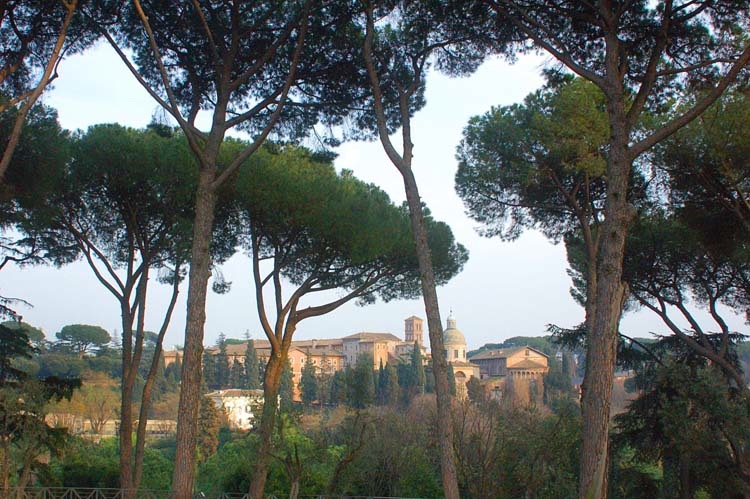
An
Art Deco gem situated right
in the center of Rome, the Albergo
Mediterraneo (Via
Cavour, 15; +39 06 4814276), just around the corner from
Termini station, has
provided luxury accommodations, for both business traveler and tourist,
since 1942. The façade may be pure Fascist concrete–albeit much
better than most--but the lobby is a perfect period piece that looks as
fresh and spick-and-span as though it had been finished only
yesterday.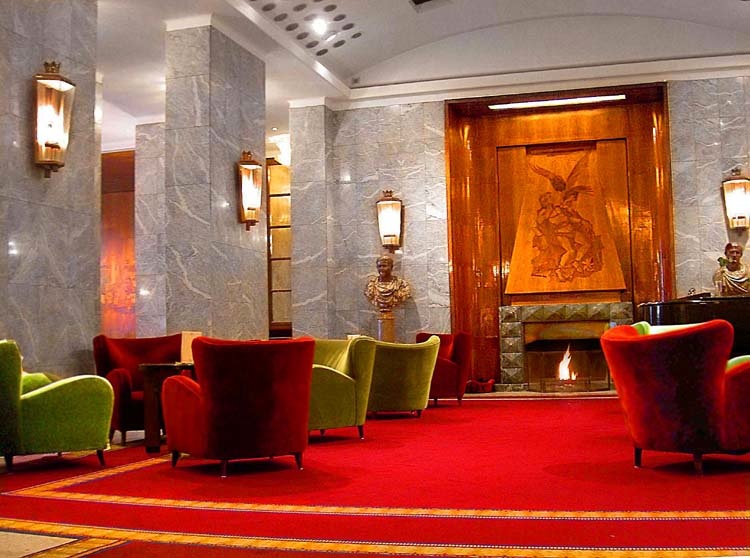
The original Reception desk faces public rooms
that are a
preservationist’s dream, with walls and floors sheathed in
beautiful figured marble as well as large marble busts of Roman
emperors. Ceiling friezes resembling white on gray Jasperware, gorgeous
frosted glass ceiling fixtures and wall sconces, overstuffed,
curvilinear armchairs, and even the inviting bar (though expensive:
$16.50
for a gin and tonic!) under its own copper marquee are all
quintessential Art Deco artifacts, as are three exceptional marquetry
panels, as beautiful as they are intriguing. The subject of the one
above the fireplace (right) is
straightforward enough: a bound Prometheus
tormented by the eagle, stealing fire having been the cause of his
dilemma.
But,
what to make of the second and most enigmatic?--a medallion-shaped
inset on the wall to the left of the bar, depicting three of the winds
that
sweep across the peninsula (clearly labeled as scirocco, libeccio, and tramontana), above them a
goat, or, is it a man in Carnival mask, offering
riches to one elegant lady, while shearing off another’s hair? The
largest and most elaborate, covering the better part of another wall,
features figures from successive epochs of Italian history, starting
with an Egyptian pharaoh and culminating in what appears to be an
Italian Romantic poet absorbed in writing a love letter.
Our ninth floor “Penthouse suite“
(foyer/dressing
room, living room, and separate bedroom behind sliding wood doors, all
beautifully appointed) more than lived up to its name, with a big
marble bathroom as well, complete with twin sinks, a large
bathtub/shower—long enough and deep enough for a six-footer to immerse
himself in-- and a nicely framed view of St. Peter’s out the window.
All the amenities of a world-class hostelry were here: a pleasant,
accommodating staff, an abundance of lush, freshly-laundered
towels and terrycloth robes, fragrant designer toiletries, concierge
service, and flat-screen TV, as well as a PC, fax and printer for
business travelers. Heavy drapes and two sets of over-sized, windows in
the living room and bedroom kept out the noise from busy Via Cavour,
while affording expansive views across gritty Roman rooftops, to the
twin Baroque domes of Santa Maria Maggiore and the 18th century statues
of Christ and His apostles atop San Giovanni in Laterano to the right,
the Alban hills in the middle distance, and, way off to the left, the
foothills and snow-capped peaks of the Apennines.
A generous breakfast buffet, served each
morning in a large refectory-type room with vaguely maritime
décor, complete with figureheads upholding the ceiling beams, is
included in the price of the room. Something is available for almost
all national tastes --eggs, bacon and cereal for the Yanks and Brits,
small flaky pastries for the French and Italians, an assortment of cold
cuts and cheeses for the Northern Europeans, as well as yogurt, fresh
fruit and fruit juices for everyone.
Right
across Via Cavour is another of
the Bettoja family’s four city hotels, Albergo Massimo D’Azeglio,
with their flagship Massimo D’Azeglio
restaurant (Via Cavour 18;
06 481 41 01) --one of the city’s oldest and best known-- taking
up
most of the ground floor.
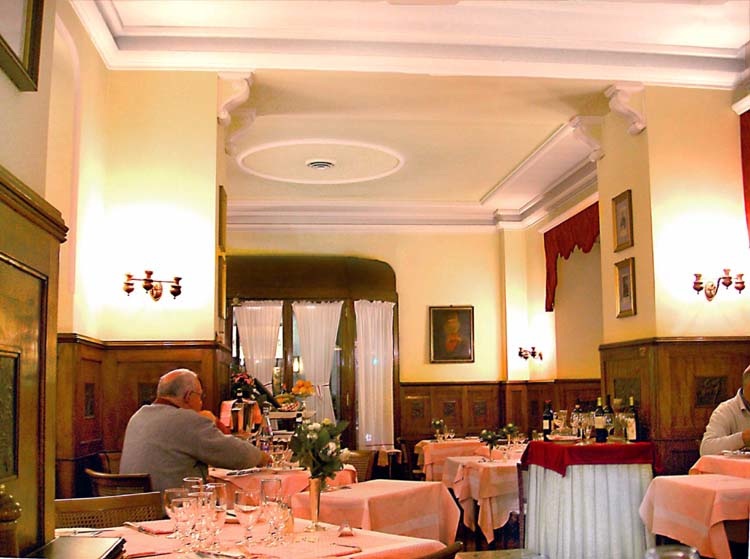 Maurizio
Bettoja, wine merchant,
relocated to Rome in 1875, and soon after opened the restaurant, then
in 1878 the hotel, above his original wine cellars. Another lovely
period piece, the dining room dates from the turn of the last century.
Deep crown molding and heavy brackets highlighted in white against pale
lemon walls, wainscoting of beautiful dark wood adorned with finely
hand-carved mahogany plaques, layers of pink napery, and
white-jacketed, bow-tied waiters adept at table-side service, all
recall a more gracious, less hurried time.
Maurizio
Bettoja, wine merchant,
relocated to Rome in 1875, and soon after opened the restaurant, then
in 1878 the hotel, above his original wine cellars. Another lovely
period piece, the dining room dates from the turn of the last century.
Deep crown molding and heavy brackets highlighted in white against pale
lemon walls, wainscoting of beautiful dark wood adorned with finely
hand-carved mahogany plaques, layers of pink napery, and
white-jacketed, bow-tied waiters adept at table-side service, all
recall a more gracious, less hurried time.
Massimo Taparelli, Marchese
d’Azeglio, one of the leaders of the Risorgimento (the national
liberation movement that culminated in the unification of Italy) was as
much artist as politician, so an important collection of paintings and
prints dealing with the Risorgimento, including four by the marchese
himself, decorate the walls.
To understand the fine art of Italian
service, look no further than Claudio Tomencioni, another of those
brilliant maître’ds who are as much a part of the country’s
patrimony
as its art, architecture, literature, wine, fashion, and its
breathtaking topography. Claudio has been overseeing the
proceedings here since 1980. At his suggestion, an antipasto di verdure, displayed in
grand style on
a large table right inside the entrance, arrived at our table. Grilled
peppers, radicchio and asparagus, fried carciofi alla Romana, and
eggplant gratin all passed
muster, as did paper-thin slices of
Prosciutto di Parma garnished with a much-enjoyed spuma di formaggio
made with delicious, tangy Taleggio. The came a correct risotto con provola affumicata e speck;
rich, earthy, fettuccine Massimo
d’Azeglio,
fresh pasta in a cream sauce garnished
wild mushrooms; and robust tonnarelli
(think spaghetti, only
squared-off rather than round) with basil, porcini, and grape tomatoes
were all packed with flavor and beautifully turned out.
Another of Claudio’s
recommendations, filetto di manzo
alla Rossini,
seemed only appropriate in this setting,
showcasing not only the fin-de-siecle gourmet’s trinity of tenderloin,
foie gras, and truffles, but an equally classic, deep, dark,
much-reduced, brown sauce as well. Prepared with care, and served with
tasty sautéed spinach and a small hillock of roast potatoes, it
showed
clearly that the standard bearers of traditional haute cuisine can be
as satisfying as they are historic.
A grigliata mista di pesce comes as
filets of swordfish, salmon, coda di
rospo (monkfish), and sea bass, as well as shrimp and calamari,
enough
for three people, but nevertheless it quickly disappeared, whereas saltimbocca
alla Romana, one of the simple gems of Roman cuisine, was good,
if not
inspiring.
I love the Sagrantino grape, whose heretofore
untamable tannins now survive even the most aggressive
modern/international wine-making
practices to give a nice edge to each mouthful of wine. Ours was a
big, bold Sagrantino di Montefalco 2001 (36 euros) from Terre di Trinci
one of Umbria’s better, and better-known cooperatives.
The original wine cellars--the real thing,
not some
highly varnished, recently added attraction--complete with compressed
dirt floors, candlelight, and spindly wood shelves filled with
dust-covered bottles, some dating back to the 19th century, are
available for private parties.
Antipasti: 10 to 16 Euros; primi: 9 to
14; secondi: 14 to 26; dolci: 5
to 7.
A short
walk from the hotel past
Santa Maria Maggiore is Trattoria
Monti (Via San Vito 13A; 06
446 65 73), at
the moment one
of Rome’s most popular restaurants for tourists and locals alike. It’s
sought out as much for the two handsome brothers, Enrico and Daniele
Camerucci, who adorn the dining room, as for the dishes prepared in the
kitchen by their mother, Franca, whose family hails from Le
Marche. Reservations are a must; a steady
stream of would-be diners were turned away the evening we were there.
The room has recently been redone,
Don’t pass up the trattoria’s signature antipasto, a starter that pairs
delicious breaded, stuffed, fried olives ascolane (three weren’t nearly
enough), with equally yummy battered and fried fiori di zucca,
artichokes alla romana, and a
new-to-me salumi called ciauscolo,
that’s
more sausage than salami, so soft and fatty that it’s spreadable. Red
onion tart with Gorgonzola was another winner; the intensely flavored
onions caramelized to a deep mahogany.
The first Romans were shepherds, and in Rome
pecorino, not parmigiano,
is king. Referring not just to the romano familiar to Americans, in
Italy, pecorino is any cheese made from sheep’s (pecora) milk, and
there are dozens of them. One example is pecorino di fossa, from
Romagna, aged in shallow caves (fosse).
At Monti, its unmistakable
flavor and aroma transforms a dish of rigatoni with sausage and black
pepper. Another unusual offering, tortellone,
one plate-sized raviolo
stuffed with ricotta and a runny egg yolk dressed with a fresh tomato
sauce looked more interesting than it tasted. I passed up the
all-but-irresistible looking roast suckling pig –I’d already had it
elsewhere two nights’ running—and chose instead roasted, stuffed
squab (piccione)
that was good if not great, while my partner fared much better with his
stinco, a long-braised,
falling-off-the-bone shin of ox, in a deep,
dark red wine sauce.
Trattoria Monti’s wine list is on a
par with its food. I couldn’t
pass up a Giacomo Bologna,Barbera d’Asti Bricco dell’Ucellone 1999 at
only 40 euros. From one of Piedmont’s top wineries, it was a big,
mature red, still with plenty of fruit, and more importantly, a nice
structured finish to complement the food.
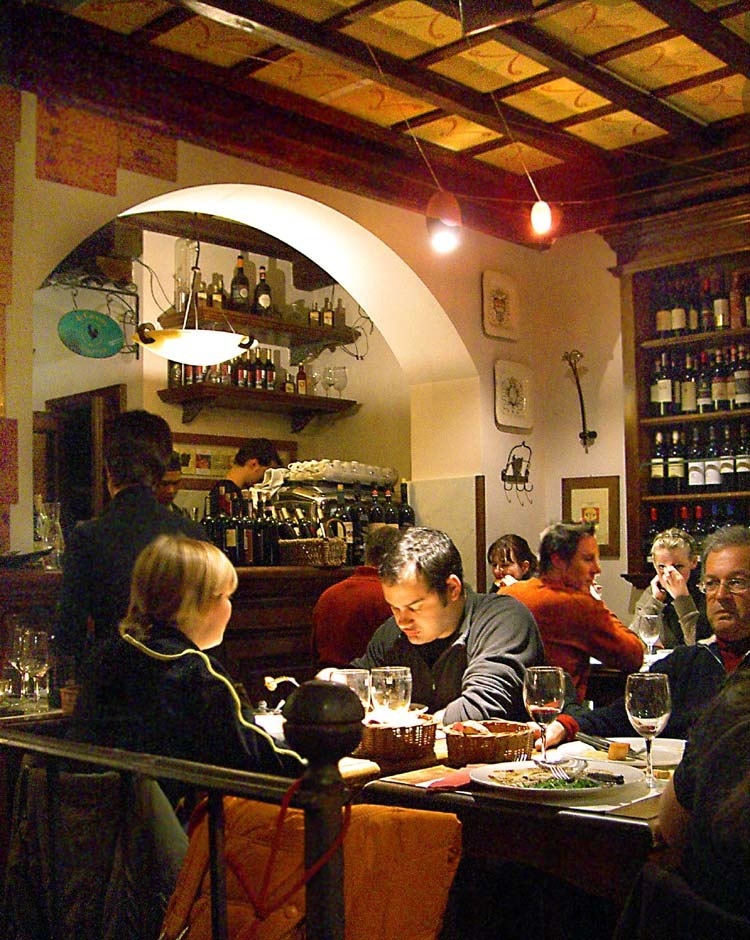 Nicola
Salvi’s magnificent, baroque Fontana di Trevi may be just about
swamped with tourists, but just around the corner is the decidedly
untouristic Vineria il Chianti (Via del Lavatore 81; 06 678 75 50).
As its name, as well as its
décor--mostly shelves filled with wine bottles--implies, this is
as much
wine bar as eatery, with a menu more Tuscan than Roman. The selection
of Chiantis is staggering. With the
help of our personable waitress, we chose a Rosso di Montalcino 2006
from the Cantine di Montalcino, one of the DOC’s best cooperatives.
These days I’m more on the lookout for acidity and tannic structure
than fruit, as so many wines are overly ripe to the point of sweetness.
This red managed to balance all three beautifully, all for only 22
Euros.
Nicola
Salvi’s magnificent, baroque Fontana di Trevi may be just about
swamped with tourists, but just around the corner is the decidedly
untouristic Vineria il Chianti (Via del Lavatore 81; 06 678 75 50).
As its name, as well as its
décor--mostly shelves filled with wine bottles--implies, this is
as much
wine bar as eatery, with a menu more Tuscan than Roman. The selection
of Chiantis is staggering. With the
help of our personable waitress, we chose a Rosso di Montalcino 2006
from the Cantine di Montalcino, one of the DOC’s best cooperatives.
These days I’m more on the lookout for acidity and tannic structure
than fruit, as so many wines are overly ripe to the point of sweetness.
This red managed to balance all three beautifully, all for only 22
Euros.
Dinner started well with an assortment of salumi, both familiar and
unusual, all delicious and leaving our palates ready for more. Pappardelle alla lepre,
broad shards of pasta with a hare sauce, is
something I seem to enjoy only in Italy, and this version was no
letdown. Equally good was pici cacio
e pepe, thick spaghetti flavored
with nothing but grated romano cheese and cracked black pepper, an all
but
extinct staple of traditional Roman cuisine that’s just starting to
find its way back into the culinary consciousness. Secondi of stracotto, or Italian pot roast,
and a thin-crust, pizza
bianca covered with fiori di
zucca were well turned-out as well.
This is
a busy, bustling, very hospitable place that welcomes a crowd of young
locals, as well as the occasional savvy tourist. Dinner for two was 82
Euros with bottled water and wine, and a preliminary glass of Tocai (5
Euros) so surprisingly good I forgot to get its name. Tables may be
close, but here I enjoyed the proximity, especially since most of the
conversations overheard were in Italian.
A meal will run 22-35
Euros.
NEXT WEEK: PART TWO OF ROME
NEW YORK CORNER
by John Mariani
PadreFiglio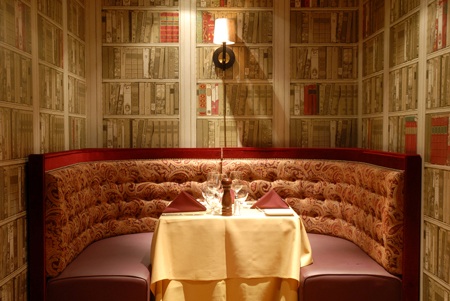
310 East
44th Street (near
1st Avenue)
212-286-4310
www.padrefiglio.com
Twenty years ago PadreFiglio
might
have been just another Italian-American restaurant serving pretty much
the same menu every other Italian-American restaurant in NYC served.
Which wasn't
so bad at all but it was rarely wonderful. The reason? The
Italian-American
restaurants of the day simply could not acquire, import, or beg for the
best Italian ingredients--from olive oil and balsamic vinegar to
Parmigiano-Reggiano to Super Tuscan wines. No one could. No white
truffles in season, no porcini mushrooms, no
bufala mozzarella.
So how could they possibly come close to the way Italian food tasted
back in Italy, not to mention the regional diversity that is true
Italian cuisine?
Fast forward twenty years and all those
wonderful ingredients are available to everyone. So, a restaurant like
PadreFiglio can now showcase the absolutely wonderful flavors of
Southern Italy the way they should taste, while at the same time
using the best American ingredients--from great beef and veal to
lobster and scallops--unavailable back in the Old Country.
All of which is in intro to saying
that I had one of the best Italian meals in a long time at PadreFiglio,
whose name refers to father and son team, Antonio and Mario Cerra, who
already operate the notable Da Antonio (157 East 55th Street), recently
sold. Together with Chef Alberto Argudo (formerly of Campagnola
and Il
Mulino), they have crafted an Italian steakhouse with strong Neapolitan
overtures. Antonio is one of the most ebullient, gregarious hosts
in NYC, and he is to be consulted on everything from how you wish you
meat to be cooked to what new wines have just entered the list of this
two-month old restaurant near the U.N.
The place itself is both rustic and
cosmopolitan, with terracotta mosaic steps, ruby glass, and wrought
iron
windows, a glass-enclosed garden room with Italian frescoes, and the
inside Venetian room with red velvet walls, paisley
banquettes, and
ebony wood brass sconces. It all has a pleasant sumptuousness,
yet it is not in the least a stuffy or formal dining venue.
Soon as you're seated
they bring you
good bread and focaccia to nibble on with your cocktails or wine from a
very fine list of Italian and other bottlings, quite reasonable priced
in all categories. Fried calamari, elsewhere a cliché are
here
paradigms of form--hot to the table, very crispy outside, very tender
within, served with a lightly spiced tomato salsa. Sea
scallops Toscana come perfectly juicy after a fast searing, served with
baby artichokes cucumbers, tomatoes and cannelloni beans,
and best of all the antipasti was a crespelle Napoletane, baby
eggplant stuffed with ricotta of buffalo's milk and baked till
creamy in a fresh tomato sauce.
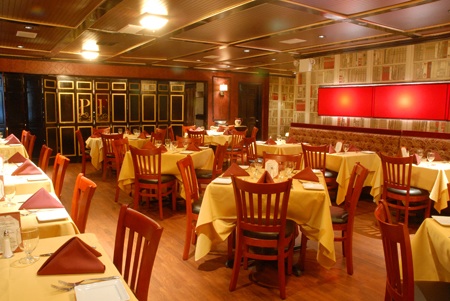 All
the pastas I tried were truly sumptuous, from an al dente rigatoni
amatriciana with tomato, basil, pancetta, and sliced onions to
orecchiette Barese, with sweet sausage, broccoli di rabe, and a good
shot of garlic. Even the appetizer portions are very generous.
All
the pastas I tried were truly sumptuous, from an al dente rigatoni
amatriciana with tomato, basil, pancetta, and sliced onions to
orecchiette Barese, with sweet sausage, broccoli di rabe, and a good
shot of garlic. Even the appetizer portions are very generous.
If you're thinking of Mediterranean
seafood, go with the snapper with a potato crust over a sweet pepper
puree. If you opt for meat, costoletta Martino is a veal chop dipped in
parmigiano with artichoke and asparagus
in a light, citric lemon sauce. Still, PadreFiglio does
announce itself as being an Italian steakhouse, and the New York strip
of Piemontese grass-fed beef has the real flavor you'd expect in
Florence but never get in U.S. steakhouses. The t-bone cut is
excellent, thick, rare, and succulent throughout, and the lamb is
Colorado's best, lightly crusted with herbs and cooked medium-rare,
with nice charring on the bones and a perfect trim of fat. You might
want to try the more exotic meats here, including Canadian wild boar or
the filet mignon of buffalo, both quite lean but flavorful.
PadreFiglio's desserts are fairly
standard but good and one is enough for two people.
With so few NYC restaurants doing this
kind of Italian food these days--at least in Manhattan--PadreFiglio
proves the whole idea that ingredients count mightily, and warm
hospitality is always a way to bring guests back.
PadreFiglio is open for lunch and dinner daily. 3-Course Lunch Menu $27. Bar menu available. Appetizers $9 – 24; Entrees $16– 48.
THE JAMES BEARD RESTAURANT AWARDS 2008
by John Mariani
This year's James Beard Awards were, overall, fairly judicious. More than 400 people voted, with 250 regional judges included. Still, the obvious biases continue, which is to say that those restaurants and chefs who get the most media attention handily win the award, even if far more worthy nominees without publicity machines, TV shows, and connections to the major food magazines deserve the awards. And when you consider that those same magazines mount lavish food and wine events around the country each year, is it any wonder that the celebrity chefs they both promote and need to draw crowds go home with most of the marbles?
High-profile chefs continue to take the prizes, even though so many of them rarely cook at all anymore. The chef who is managed by a corporation trumps the chef who maintains his connection to his singular kitchen. Still, 2008 was a year in which more working (i.e., cooking) chefs won awards than those who merely host TV shows or attend food festivals, and hoorah for that!

As someone who was for several years on the JB Restaurant Awards Committee, three as chairman, I always expressed my doubts about nominees who made the cut despite being completely unknown to most members of the committee, despite the by-laws' contention that chefs must "serve as a national standard bearer of excellence." By the same token, I know how very, very hard the committee works to get things as honest as possible, and the chronic and ignorant carping by outsiders that a chef can somehow buy his way into an award is absolute nonsense.
Which is not to say, as I already have, that a well-oiled publicity machine can work wonders in bringing chefs to the voters' attention. That translates into the high probability that many of those 400 voters who have actually have had a chance to eat in cities not their own will have eaten only at the most-hyped restaurants in the biggest cities. Let's face it, how many voters could possibly have eaten at the Alex Young Zingerman's Roadhouse in Ann Arbor, Michigan, or Hugh Acheson's Five and Ten in Athens, Georgia?
That said, here are my thoughts on the winners and losers of this year's JB Awards. My congrats to the former and latter alike.
OUTSTANDING
RESTAURATEUR AWARD: "A
working
restaurateur, actively involved in multiple restaurants in the United
States, who has set uniformly high national standards as a creative
force in the kitchen and/or in restaurant operations. Candidates must
have been in the restaurant business for at least ten years."
Award Winner
: Joe
Bastianich/Mario Batali
, Babbo
NYC--This dynamic duo
certainly deserves credit for the excellence of innovative restaurants
like Babbo, Lupa, Esca, and Del Posto, and they have bettered other
2008 nominees like Tom Douglas
, Tom
Douglas Restaurants,
Seattle;
Wolfgang Puck
, The Wolfgang Puck Fine Dining Group
, Beverly
Hills; and Jean-Georges Vongerichten
and Phil Suarez,
Jean-Georges Management LLC, NYC. I thought
the
best among the nominees, however, is the quieter but far more
consistent Richard Melman
, Lettuce
Entertain You Enterprises
, Chicago, which for four decades has
been in the forefront of the modern American restaurant industry.
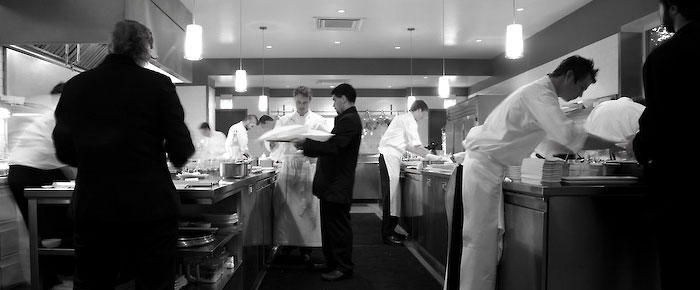
OUTSTANDING CHEF AWARD: "A
working chef in America whose career has set national industry
standards and who has served as an inspiration to other food
professionals. Candidates must have been working as a chef for at least
the past five years."
Award Winner
: Grant Achatz
,
Alinea, Chicago (left). How could he not win? Profiled (for his battle
with mouth cancer) in The New Yorker,
with Alinea called the best restaurant in the U.S. less than six months
after opening by Gourmet Magazine,
Achatz has had more media hype than any chef in memory I (except,
perhaps, David Chang: see below), for dishes like his limp bacon strip
on a silver thread and linen pillows inflated with herbs, on menus that
add up to 28 courses and four-hour meals. Has his not-very-long career
actually "set national industry standards?" I don't think
so. Far more deserving are nominees José Andrés
of minibar by
josé andrés,
Washington, DC, and Dan
Barber of
Blue Hill, NYC, and the unique Blue Hill at Stone Barns in
Pocantico, NY.
OUTSTANDING
RESTAURANT AWARD: "Candidates
must have been in operation for at least ten consecutive years."
Award Winner
: Gramercy
Tavern, NYC
, Owner: Danny Meyer: Richly deserved in a
category with very strong contenders like Boulevard, San Francisco
, Chef/Owner Nancy Oakes,
Owner, Pat Kuleto; and Jean Georges, NYC:
Chef/Owner: Jean-Georges
Vongerichten, Owner: Phil Suarez. San Francisco's Slanted Door, however, doesn't
belong among this group at all, beloved in San Francisco but having had
no impact on the rest of American gastronomy or even California
cuisine.
BEST
NEW RESTAURANT: "A restaurant
opened in 2007 that already displays excellence in food, beverage, and
service and is likely to have a significant impact on the industry in
years to come."
Award Winner: Central Michel
Richard, Washington, DC
; Chef/Owner: Michel Richard: This is
absolutely bewildering! While Richard is
one of America's greatest
chefs, but at its best Central is a good French bistro, not in
any way innovative and rarely sees an appearance
by Richard, who has been busy opening up restaurants elsewhere.
Central will have no impact whatsoever on the industry in years to
come. On the other hand, Anthos, NYC,
whose exciting
young Chef/Owner Michael Psilakis has transformed
modern Greek cuisine is far more deserving in every sense. And veteran
Chef Dean Fearing's Fearing's
in Dallas is a spectacular restaurant with food no one else is doing in
or out of Texas. He has for decades been a leader and inspiration to
chefs.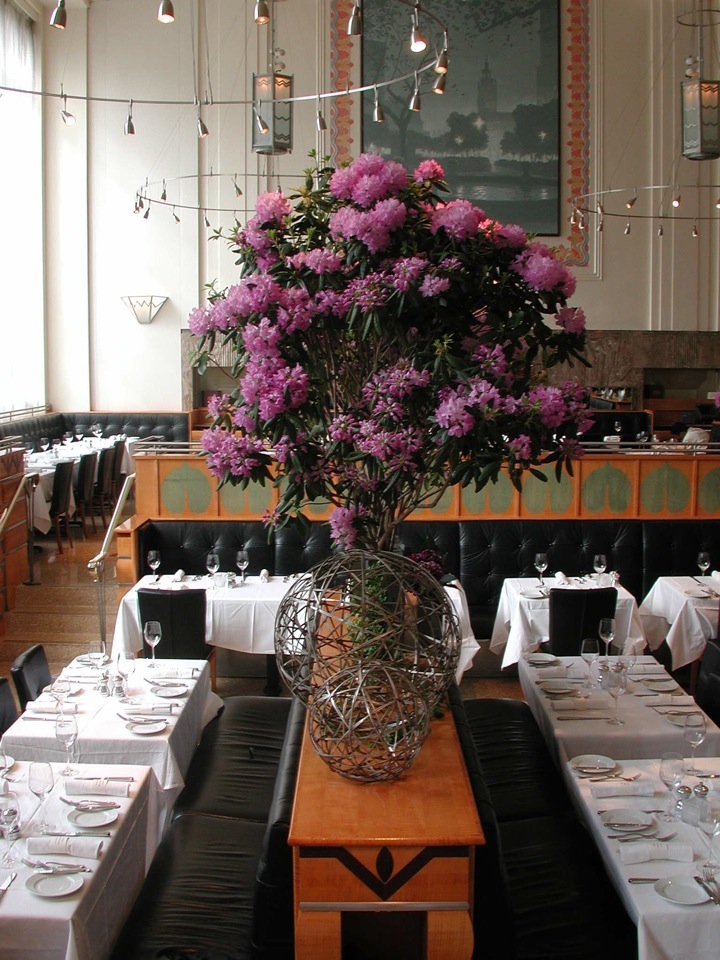
RISING STAR CHEF OF
THE YEAR AWARD: "A chef age 30
or younger who displays an impressive talent and who is likely to have
a significant impact on the industry in years to come."
Award Winner
: Gavin Kaysen ,
Café Boulud, NYC. Fair enough, although
he's only been cooking at Cafe Boulud for a few months and I
haven't heard much about him. It was not a strong category this
year.
OUTSTANDING WINE
SERVICE AWARD: "A restaurant
that displays and encourages excellence in wine service through a
well-presented wine list, a knowledgeable staff, and efforts to educate
customers about wine. Candidates must have been in operation for at
least five years."
Award Winner
: Eleven Madison
Park, NYC
(right); Wine Director: John Ragan: Another
Danny Meyer restaurant, and the winelist and service are
outstanding. Still, other nominees like Blackberry Farm, Walland, TN
; Wine
Director: Andy Chabot, and Picasso,
Las Vegas
; Wine Director: Robert Smith, would be equally deserving.
OUTSTANDING WINE AND
SPIRITS PROFESSIONAL AWARD: "A
winemaker, brewer, or spirits professional who has had a significant
impact on the wine and spirits industry nationwide."
Award Winner
: Terry Theise
Terry Theise Estate Selections
, Silver Spring, MD: OK by me, though he doesn't
exactly leap to mind in this category.
OUTSTANDING SERVICE
AWARD: "A restaurant that
demonstrates high standards of hospitality and service. Candidates must
have been in operation for at least the past five years."
Award Winner:
Terra
,
St. Helena, CA
, Owners: Hiro Sone and Lissa Doumani: A good choice,
though two others--Canlis
,
Seattle
, Owners:The Canlis Family; Spiaggia,
Chicago,
Owner: Tony Mantuano--are equally as good.
BEST CHEFS IN AMERICA: "Each candidate may be employed by any kind of dining establishment and must have been a working chef for at least the past five years. The three most recent years must have been spent in the region where chef is presently working. "
BEST CHEF: PACIFIC
(CA, HI)
Award Winner
: Craig Stoll,
Delfina
, San Francisco--Excellent choice, though I'd lobby for
nominee Douglas Keane
at Cyrus
,
Healdsburg, CA.
BEST CHEF:
MID-ATLANTIC (DC, DE, MD, NJ, PA, VA)
Award Winner:
Eric
Ziebold
, CityZen, Washington, DC
--Another excellent choice.
BEST CHEF: MIDWEST
(IA, KS, MN, MO, NE, ND, SD, WI)
Award Winner
: Adam Siegel
Bartolotta's Lake Park Bistro,
Milwaukee--I can't say I know
this region well enough to comment.
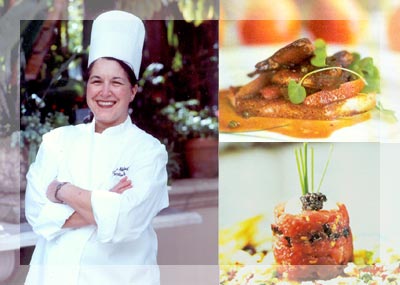
BEST CHEF: GREAT LAKES (IL, IN, MI, OH)
Award Winner
: Carrie
Nahabedian
(left), Naha,
Chicago
--Well deserved,
although the other nominees were pretty weak.
BEST CHEF: NEW YORK
CITY
Award Winner
: David
Chang,
Momofuku Ssäm Bar--Big freaking surprise! Everybody
knew that Chang--who has been hyped up as a genius, despite his own
contention that "I always thought I was the worst cook in the kitchens
I
worked in"--was the odds-on favorite, even if his winning this early
in his career was out of all touch with reality. And the award is
not
even for his new Ko, which has
gotten all the powerhouse publicity. As
Ryan Sutton, restaurant critic for Bloomberg
News put it, "David Chang, who doesn't hold a single Michelin
star and who
likes to play AC/DC at high volumes for his sometimes astonished
guests, received the best New York City chef award. He beat out a cast
of all Michelin-starred rivals, including Terrance Brennan of the
two-starred Picholine and
Gabriel Kreuther of the one-starred The
Modern. Chang is just 30 years old."
BEST CHEF: NORTHEAST
(CT, MA, ME, NH, NY STATE, RI, VE
Award Winner
: Patrick
Connolly
, Radius
, Boston: Very good choice from a fairly weak
slate.
BEST CHEF: NORTHWEST
(AK, ID, MT, OR, WA, WY)
Award Winner
: Holly
Smith
, Café Juanita
, Kirkland, WA--Happy choice,
although Ethan Stowell
of Union
in Seattle is a more innovative chef likely to have an
impact in the region.
BEST CHEF: SOUTHEAST
(GA, KY, NC, SC, TN, WV)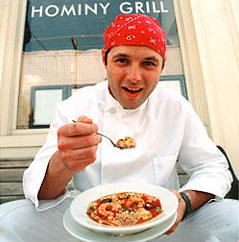
Award Winner
: Robert
Stehling
Hominy Grill
(right),
Charleston, SC-- I love Stehling's downhome cooking at the Hominy
Grill, but compared to the brilliance of Arnaud Berthelier
at The Dining Room
The Ritz-Carlton,
Buckhead
/Atlanta;Linton Hopkins
of Restaurant
Eugene
, Atlanta; and Mike Lata of
Fig
, Charleston, SC, there is no
comparison.
BEST CHEF: SOUTHWEST
(AZ, CO, NM, NV, OK, TX, UT)
Award Winner
:
Lachlan Mackinnon-Patterson,
Frasca Food and Wine
, Boulder,
CO--A great choice in a very strong category this year.
BEST CHEF: SOUTH (AL, AR,
FL, LA, MS)
Award Winner
: Michelle
Bernstein,
Michy's
, Miami--Bernstein is a media
darling--mine too--though I don't think Michy's is her best work by far
and has no impact nationally or regionally. But the rest of the
nominees were pretty flat.
~~~~~~~~~~~~~~~~~~~~~~~~~~~~~~~~~~~~~~~~~
NOTES FROM THE WINE CELLAR
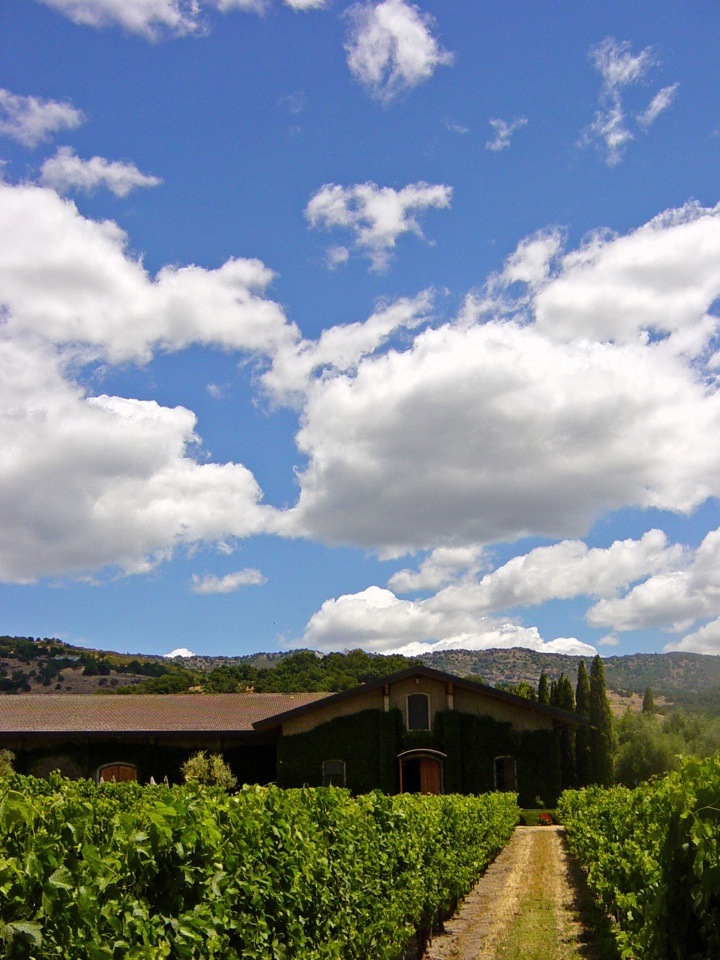 Now They
All Copy Clos du Val
Now They
All Copy Clos du Valby John Mariani
Photo by Ralph White
When
California entrepreneur John
Goelet sent his partner, Bernard Portet, to France in 1970 to learn how
to make world-class wines in the Napa Valley, the sixth- generation
winemaker returned and tried to imitate the traditional blends of
Bordeaux cabernets, with merlot, cabernet franc, and other varietals.
Their first release was in 1972.
That was at a time when the fledgling Napa
Valley wine industry was distancing itself from such traditions in
favor of blockbuster, 100 percent cabernets that impressed the media
but were rarely well-structured, complex wines. Now, 36 years
later, nearly every Napa Valley cabernet vintner follows the Clos du
Val lead to blend.
The intent at Clos du Val has always
been
to make well-knit, elegant wines that showed good aging potential, and
from the first vintages their wines bore strong comparison to some of
the best classified growths of Bordeaux. Appropriately, the winery’s
label, based on a small 17th century German statue, depicts The Three
Graces—Aglaia (Splendor), Euphrosyne (Mirth) and Thalia (Good Cheer) of
Greek mythology (below).
The holdings of the original 150 acres
in the Stag’s Leap viticultural appellation were increased in the 1970s
with 180 acres in Carneros. The winery evolved into making stellar
chardonnay without the overwhelming oak and alcohol of so many other
Napa productions, a well-balanced pinot noir, and a widely respected
easy-to-drink merlot.
I have drunk Clos du Val with pleasure
over the decades since I first visited the winery back in 1977, and
even though it has grown in production capacity, the wines have
maintained the kind of structure and consistency they always
intended. They are also wines that are nicely mature when they
are released, although the bigger cabs, like the full-bodied 2005 ($32)
definitely will improve in bottle for the next four to five years.
That was a big production year for their
cab—40,000 cases—from the largest vintage ever, but the wine shows far
more body and ripeness than I might have expected for such a big crop.
The nice dark fruit colors are still harmonizing with tannins just
starting to loosen up. Its composition was 85 percent cab, 10 percent
cabernet franc, 3 percent merlot, and 2 percent petit verdot.
Clos du Val’s flagship cabernet,
the 2004 Stags Leap
District ($70), with just 4,300 cases made, is magnificent, very
intense, but not cloying in the overripe style of other California
cabs. It will age for a decade or more and mellow out beautifully in
the next five years.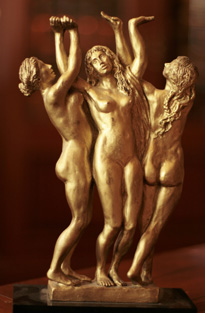
Clos du Val’s merlots have consistently
been very warm, very satisfying interpretations of a varietal that is
too often one dimensional. I did, however, find wide inconsistency in
the 2005 bottlings—one was corked, another oddly dull, and a third
very, very fine. This last had plenty of complexity and the
softness I love about merlot, even when it’s young—an ideal wine with
roast pork of veal.
Their 2006 Chardonnay is delightfully
crisp, with reasonable vanilla notes but not that sweet caramel flavor
or oakiness some vintners shamelessly strive for. Described in
Clos du Val’s notes as enjoying weather that was throughout the 2006
harvest “perfect,” this chardonnay, from a cool Carneros climate, is a
very good buy at $24 and very typical of Clos du Val’s attention to
subtlety over power.
I’m not quite as familiar with Clos du
Val’s pinot noirs, but the 2006 ($30)—which needs no aging—has a
lovely, rosy bouquet, with good cherry-raspberry flavors, and a nice
bite of pepperiness that makes it such a good red wine for chicken
dishes and fatty fish like salmon and mackerel.
Those who like wines to “knock their
doors off” are not likely to favor Clos du Val. But those looking
more for the true taste of the fruit and the pleasure of letting the
wine flow throughout the palate will be richly rewarded with wines that
also don’t cost a fortune.
John
Mariani's weekly wine column appears in Bloomberg Muse News,
from which this story was adapted. Bloomberg News covers Culture from
art, books, and theater to wine, travel, and food on a daily basis, and
some of its articles play of the Saturday Bloomberg Radio and TV.
REST
IN PABST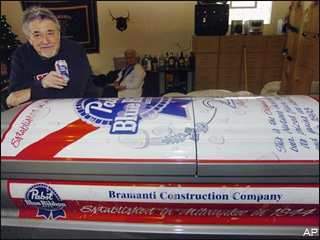
In
South Chicago Heights, Bill Bramanti had a casket custom-made by Panozzo Bros. Funeral Home with his
favorite beer's colors, Pabst Blue Ribbon. "I actually fit, because I
got in here," said Bramanti, 67, who threw a party for friends
and filled the casket with Pabst. His daughter Cathy remarked, ""Why
put such a great novelty piece up on a shelf in storage when you could
use it only the way Bill Bramanti would use it?"
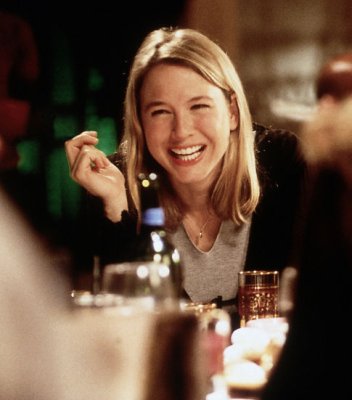
IT DIDN'T HURT PINOT NOIR SALES
WHEN THAT IDIOT MILES IN "SIDEWAYS" DRANK THE SPIT BUCKET
"Chardonnay has made some of the world's greatest wines. Everyone appreciated it – until Bridget Jones. Bridget Jones goes out on the pull, fails, goes back to her miserable bedsit, sits down, pours herself an enormous glass of chardonnay, sits there with mascara running down her cheeks saying, 'Dear diary, I've failed again, I've poured an enormous glass of chardonnay and I'm going to put my head in the oven.' Great marketing aid! Until Bridget Jones, chardonnay was really sexy. After, people said, 'God, not in my bar'.""—British wine writer Oz Clarke.
QUICK
BYTES
*
On June 18 San Domenico NY
hosts an Alumni Chef Reunion Dinner to benefit the Food Bank For
NYC, with chefs Benny Bartolotta (Osteria del Circo), Andrew Carmellini
(A Voce), Scott Conant (Scarpetta), Theo Schoenegger (The Patina
Group), and San Domenico NY executive chef Odette Fada. Join
owners Tony May and Marisa May with special guest Gianluigi Morini,
founder and proprietor of San Domenico Imola in Italy. Wines from
Castello Banfi. $600 pp. Call 212-265-5959.
* On June 20, in
Arlington Heights, ILL, Le Titi
de Paris, in its continuing Global Wine Dinner Series, will
highlight Spanish Sherries, Fino to Pedro Ziminez, hosted by Sommleier
Marcel Flori, with a menu by Chef Michael Maddox. $85 pp.
Call 847-506-0222.
* On June 21 in Washington, DC, Taberna del Alabardero partners with Gonzalez Byass, owner of several sherry wineries, to offer dinner guests a one-night-only sherry spectacle. A venenciador (Flamenco-like sherry pourer) will fill guests’ complimentary glasses with sherry, along with appetizers, from A&H Seafood Market, owned by Santi Zabaleta, Taberna ‘s former chef. Call 202-429-2200 or visit www.alabardero.com
* On June 25 in Oak Brook, Ill, Reel Club will be serving up “summer” when Master Sommelier Alpana Singh hosts a 4-course Summer Wine Dinner prepared by Executive Chef Mychael Bonner. $75 pp. Call 630-368-9400; www.reel-club.com.
* Starting June 26
in Washington, DC in honor of the “Lion King” performances at the
Kennedy Center, the Roof Terrace
Restaurant has created a family offer extended throughout the
musical’s run. Executive Chef Joe Gurner and Chef de Cuisine Karen
Hayes will showcase two family-focused pre-fixe menus – one for adults
($35) and one for children ($15)– and lion-inspired desserts.
Call 202-416-8555 or visit www.roofterracerestaurant.com
* On June 29 Chef Shaun Doty of Shaun’s in Atlanta will feature a
special 4-course menu featuring Terrapin Beers , with co-founder and
Brewmaster Brian “Spike” Buckowski, with $60 with beer pairings
and $45 without the beer pairings. Call 404.577.4358
www.terrapinbeer.com.
Everett Potter's Travel Report:
I consider this the best and savviest blog of its kind on the web. Potter is a columnist for USA Weekend, Diversion, Laptop and Luxury Spa Finder, a contributing editor for Ski and a frequent contributor to National Geographic Traveler, ForbesTraveler.com and Elle Decor. "I’ve designed this site is for people who take their travel seriously," says Potter. "For travelers who want to learn about special places but don’t necessarily want to pay through the nose for the privilege of staying there. Because at the end of the day, it’s not so much about five-star places as five-star experiences." To go to his blog click on the logo below: THIS WEEK: An interview with Bob Spitz, author of The Saucier's Apprentice: One Long Strange Trip Through the Great Cooking Schools of Europe; A Walking Tour in Tuscany; and Richard West on The Geography of Bliss.

~~~~~~~~~~~~~~~~~~~~~~~~~~~~~~~~~~~~~~~~~~~~~~~~~~~~~~~~~~~~~~~~~~~~~~~~~~
Eating Las Vegas is the new on-line site for Virtual Gourmet contrinbutor John A. Curtas., who since 1995 has been commenting on the Las Vegas food scene and reviewing restaurants for Nevada Public Radio. He is also the restaurant critic for KLAS TV, Channel 8 in Las Vegas, and his past reviews can be accessed at KNPR.org. Click on the logo below to go directly to his site.
~~~~~~~~~~~~~~~~~~~~~~~~~~~~~~~~~~~~~~~~~~~~~~~~~~~~~~~~~~~~~~~~~~~~~~~~~~~
Tennis Resorts Online: A Critical Guide to the World's Best Tennis Resorts and Tennis Camps, published by ROGER COX, who has spent more than two decades writing about tennis travel, including a 17-year stretch for Tennis magazine. He has also written for Arthur Frommer's Budget Travel, New York Magazine, Travel & Leisure, Esquire, Money, USTA Magazine, Men's Journal, and The Robb Report. He has authored two books-The World's Best Tennis Vacations (Stephen Greene Press/Viking Penguin, 1990) and The Best Places to Stay in the Rockies (Houghton Mifflin, 1992 & 1994), and the Melbourne (Australia) chapter to the Wall Street Journal Business Guide to Cities of the Pacific Rim (Fodor's Travel Guides, 1991). THIS WEEK: A Report on The Four Seasons Jackson Hole. Click on the logo below to go to the site.

~~~~~~~~~~~~~~~~~~~~~~~~~~~~~~~~~~~~~~~~~~~~~~~~~~~~~~~~~~~~~~~~~~~~~~~~~
MARIANI'S VIRTUAL GOURMET NEWSLETTER is published weekly. Editor/Publisher: John Mariani.
Contributing Writers: Robert Mariani,
Naomi
Kooker, Suzanne Wright, John A. Curtas, Edward Brivio, Mort
Hochstein, Suzanne Wright. Contributing
Photographers: Galina Stepanoff-Dargery, Bobby Pirillo. Technical
Advisor: Gerry McLoughlin.
Any of John Mariani's books below
may be ordered from amazon.com by clicking on the cover image.
 My
newest book, written with my brother Robert Mariani, is a memoir of our
years growing up in the My
newest book, written with my brother Robert Mariani, is a memoir of our
years growing up in the For those of you who don't think of the Robert and I think you'll enjoy this very personal look at our --John Mariani |
 |
 |
 |
 |
 |
 |
© copyright John Mariani 2008
